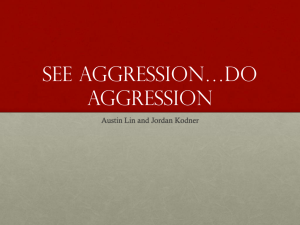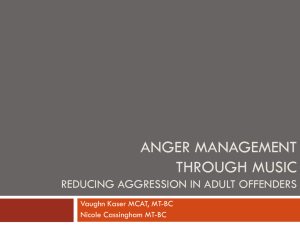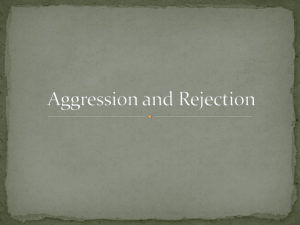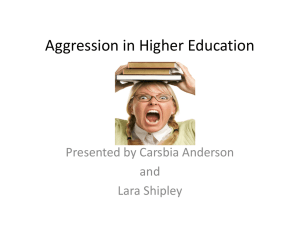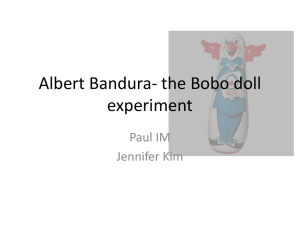Assessment and Treatment of Aggressive Behavior in Children
advertisement
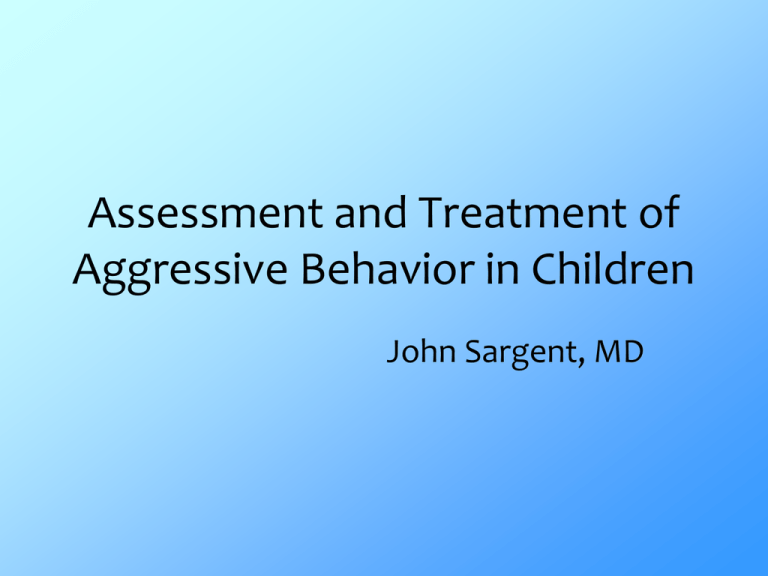
Assessment and Treatment of Aggressive Behavior in Children John Sargent, MD Aggression is behavior that is unwanted and is perceived by the person that receives it as intrusive and harmful Aggression generally has 3 purposes: 1.) to gain resources 2.) to protect personal/familial safety and resources 3.) to defend and build one’s prestige, status or power Aggression is more likely when 1.) the victim is in an out group/ depersonalized 2.) the perpetrator feels threatened 3.) the benefits exceed the cost/risk 4.) social status increases as a result of aggression Aggression also often accompanies psychiatric disorders Reasons include 1.) High negative emotionality leading to low threshold for anger or tolerance for frustration Reasons include (cont.) 2.) Distorted cognitions may lead to unwarranted alarm or erroneous beliefs Reasons include (cont.) 3.) High anxiety can lead to harmful escape or avoidance behaviors Reasons include (cont.) 4.) Inadequate impulse control can lead to use of disinhibited aggressive behaviors Reasons include (cont.) 5.) Delayed cognitive or communicative development may lead to aggressive behaviors as a method of communicating emotions or desires Reasons include (cont.) 6.) Significant maltreatment may lead to both a decrease in empathy and modeling of aggressive behavior Aggression may also be a common and acceptable means of resolving conflict or managing behavior in some families/ contexts. Thus it may be adaptive in those environments Aggression commonly begins in childhood: 27% of parents of 3 year olds report that the child hits at least sometimes. 58% of preschool children demonstrate some aggressive behavior This progresses to continued fighting and also bullying and teasing – 8% of boys fight frequently, 15-20% engage in bullying Aggression is a common cause for requesting mental health assistance Violence (as distinct from aggressive behaviors) among adolescents is often a group activity and most often is perpetrated by adolescents upon adolescents Two Types of Aggression 1.) Proactive/instrumental 2.) Reactive/affective Proactive 1.) Has a goal 2.) Is controlled and directed 3.) Not necessarily planned, may be opportunistic Proactive (cont.) Proactive aggression includes group antisocial activity and callous/unemotional aggression Reactive Reactive aggression is behavior that responds to a perceived hurt, slight or violation Reactive (cont.) Often includes hitting, biting, kicking and self-injurious behavior. Often accompanied by shouting and verbal outbursts Reactive (cont.) Appears instantaneous and unplanned, often with significant negative consequences for the aggressive child Aggression can be overt or covert and can be direct or indirect (cyberbullying) 2 longitudinal courses of antisocial behavior are seen – early childhood onset, which commonly persists to adulthood, and adolescent onset with an end in early adulthood Aggression is often multifactorial and reflects the reality that risk factors often occur together: poverty, modeled aggression, poor verbal skills, abuse, etc. Assessment of children brought for treatment of aggression includes A.) Impulse control B.) Disinhibition C.) Predominant affect - Temperament Assessment…(cont.) D.) Degree of affective reactivity and capacity for modulation of affect E.) Predominant parenting style F.) Parent-child Relationships Assessment…(cont.) G.) Presence of abuse and neglect H.) Whether the aggression achieves a goal I.) Whether one observes useful aggressiveness Assessment…(cont.) J.) Language ability K.) IQ Common Diagnoses Associated with Aggression • ADHD • Conduct Disorder • Oppositional Defiant Disorder • Depression • Head Injury Common Diagnoses Associated with Aggression (cont.) • Mental Retardation • Pervasive Developmental Disorder • Bipolar Disorder • PTSD • Dyslexia Get best history of context/antecedents, outcomes, frequency, severity of aggression Treatment Algorithm 1.) Identify diagnoses present 2.) Identify environmental targets for intervention 3.) Seriously consider treatment for primary underlying problem (e.g. ADHD) Treatment Algorithm (cont.) 4.) Change only 1 thing at a time 5.) Pursue psychosocial interventions – organize day, establish bedtime, ensure adequate food intake, increase daily structure Treatment Algorithm (cont.) 6.) Pursue psychosocial therapies 7.) Consider antiaggression medication 8.) Always utilize rating scale or episode calendar Evidence Based Psychosocial Treatments • Parent Management Training • Parent-Child Interaction Therapy • Multisystemic Therapy • Structural Family Therapy • Trauma Focused Cognitive Behavioral Therapy Specifically these interventions render aggression • Irrelevant • Ineffective • Inefficient by changing antecedents by changing consequences by developing alternatives Putting aggressive children and youth together (groups, detention) make aggression worse Psychopharmacology • Stimulants if warranted (ADHD) • Antipsychotics – most used Risperdal has most data and has an FDA indication for use in children with autism Psychopharmacology (cont.) • Mood Stabilizers Lithium has mixed data Divalproex has some positive results in treating aggression in irritable youth Psychopharmacology (cont.) • Clonidine is used but there is limited data • Benzodiazepines can be disinhibiting (not indicated) Psychopharmacology (cont.) Psychopharmacology is aimed at target symptoms – arousal, excitability, irritability, not aggression itself Psychopharmacology (cont.) JS choice: low dose risperidone if needed add divalproex Psychopharmacology (cont.) Discontinue meds after 6 months of improvement, taper one at a time Refer early, maintain long term availability, actively involve parents in care May be a relapsing and remitting course often associated with contextual variables

